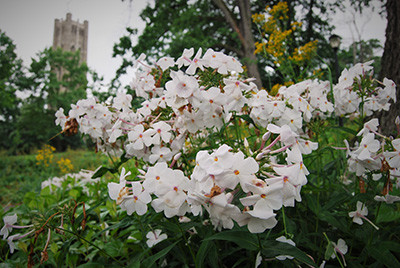
Plants of the Week: June 12
Phlox ‘Minnie Pearl’
This low-growing, white-flowered Phlox is an easy choice for the backbone of a garden. ‘Minnie Pearl’ is the first Phlox to bloom in the season and will slowly self-seed to mix with other perennials. Its fragrant, white, star-shaped flowers with gold eyes are excellent at attracting hummingbirds and butterflies; they are also superb cut flowers. ‘Minnie Pearl’ has proven to be very mildew resistant, impervious to wilt, and immune to bacterial spot, making this a fantastic option even after the blooms have faded and all that’s left is foliage. Although this miniature beauty was originally found accidentally by the side a the road in MIssissippi, it can now be found along Magill Walk at the Scott Arboretum.
Growing 15 to 20 inches tall, ‘Minnie Pearl’ needs to be planted in full to partial sun with well draining soil. It can form a 2-foot wide patch in 3 years, providing a crisp and clean appearance as an addition to borders and informal gardens. Under ideal conditions, this plant can live for approximately 10 years. There is occasional upkeep with Phlox; it should be cut back at the end of autumn in preparation for winter. Photo credit: R. Armstrong
Eryngium x zabelii ‘Big Blue’
These stunning blue beauties are as picturesque as they are prickly. From early to mid-summer in the Terry Shane Teaching Garden, Eryngium x zabelii ‘Big Blue’ will have bright violet-blue flowers atop four foot stems full of silver-green spiny foliage. Also known as Sea Holly, this herbaceous perennial has blooms that hold their color while the rest of the flowers develop, until the entire stem is full of mature blossoms. This thistle-like blossom is fantastic for cut flower arrangements, fresh or dried.
Thriving in full sun and well-drained, sandy soil, ‘Big Blue’ is resilient once established but prefers to not be disturbed. Plants can be dug up to be moved or divided if necessary, but due to their long taproot, it can be quite difficult and they will be slow to recover. Sea Holly is long-lived, hardy, withstands neglect during dry spells, and is tolerant of salt.
Eryngium x zabelii requires occasional maintenance and upkeep. It is best to cut it down in early spring before active growth; deadhead throughout the season to prevent self-seeding. Photo credit: R. Armstrong
Hydrangea macrophylla ‘Penny Mac’
The Hydrangea Collection along Whittier Place is well on its way to being in full bloom. A first to present its flowers is Hydrangea macrophylla ‘Penny Mac’. This hydrangea was named after Penny McHenry, the founder of the American Hydrangea Society. She received the plant as a gift in 1975 and spent years propagating, planting, and dispersing this hydrangea, which always seemed to bloom well in her gardens.
H. macrophylla is one of the most common species of Hydrangea. This deciduous shrub can grow to be 4- to 6-feet high and wide. Also known as a bigleaf hydrangea, its blossom colors can vary from blue to pink depending on soil acidity. Acidic soil produces blue flowers and basic soil produces pink flowers. H.macrophylla continuously blooms from late June through August on old and new growth. ‘Penny Mac’ will reliably flower each year, and is hardy to USDA Zone 5.
Finalizing the construction near the Hydrangea Collection calls for the landscape to be restored. Along with some large trees, the established Hydrangea collection has been undamaged, offering a sense of age to the land that is sometimes more difficult to accomplish with new buildings. Photo credit: R. Armstrong








No Comments